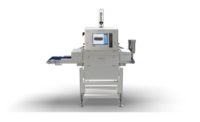Integrated Solutions
By Joshua Lipsky, Senior Editor
As more poultry processors turn away from whole bird sales, portion-control components have become the nucleus of poultry-processing innovations.
As consumers and subsequently retailers demand more value-added and convenience-driven poultry items, portion-control and cutting-edge (forgive the pun) cut-up systems are must haves for any poultry processor. In its infancy, portion control was simply a rudimentary cut-up system, often times a single operator/butcher responsible for either halving or quartering a broiler. Today, portion-control system components are used immediately following chilling and occupy vast amounts of real estate on the processing floor.
Vision technology/ grading
Processors are becoming more dependent upon revolutionary new vision systems to either create or measure exact portion-control cuts. Whether its pre- or post-cut, vision systems provide an objective, scientific, and automated method to capture batch samples and product specifications.
Dapec’s Digital Grading System uses vision technology to perform a wide variety of tasks in the grading of birds before proceeding through the cut-up system. With user-selectable parameters, the Digital Grading System is capable of monitoring up to nine grades including missing or damaged parts, discoloration, remaining feathers, torn skin, and more. The system also reports the percentages of birds in the various grades and reasons for failing.
A high-resolution color CCD camera is used to take photographs of every bird that passes through the system, and it is interfaced with specifically developed software through a conventional PC.
“With better grade out, the chances that you’ll have the right chicken in the right place is significantly improved,” explains Peter Goffe, Dapec’s president. “Ultimately, this improves yield.”
Marel’s Q-Vision is a quality sampling and measurement system with automatic feature measurement and data collection for SPC reporting. Further automating the process, using the Q-Vision System with its fully standardized feature measurement, allows processors to perform more sampling with less number of quality assurance (QA) operators.
Product samples are gathered from a line run or from finished product and brought to the Q-Vision system. The operator keys in relevant information regarding the sample and then feeds products one by one, by naturally placing the product on the infeed end of the conveyor.
Q-Vision utilizes a dynamic weighing and laser vision to measure product features automatically. More consistent and effective than manual sampling, automatic feature measurement ensures reliable results for quality sampling and reporting.
Gathering the results is only half of the Marel solution, with interpreting the results representing the other half. Marel’s MPS software provides the framework for the Q-Vision system results. The MPS QC software module collects data from the integrated weighing and vision unit, as well as the M6000 controller and provides reports on the sampling. Weight, length, width, and thickness are measured with the dynamic weighing and vision technology, and the data transferred to a database for collection and reporting. Inspections can be directly linked to production or final products for ultimate traceability.
The Stork AQS-NT improves on its AQS stand-alone installation used to grade whole birds. The new AQS-NT system assigns quality grades to eight anatomical portions at a line speed of up to 12,000 bph. Each of the portions is photographed three times from different angles to identify imperfections. Carcasses are then assigned by the PDS-NT control system to a compatible ACM-MX portioning line to achieve optimal weight and grade. The computerized system is capable of accumulating, assembling, and retrieving data on the physical appearance and defects of processed carcasses.
The Meyn Process Control System comprises a camera, drop station, and re-hanger, coordinated by an M-300 computer. The system scans anatomical portions including each wing and leg and three segments of the breast for adherent blood, bruises, lacerations, inflammatory lesions, and residual wing feathers. The system, which is installed after air chilling, incorporates flock identification and provides high sensitivity and accuracy with varying line speed.
Sizing and weighing
Portion weighing and sizing is a vital consideration for many processors servicing either institutional or domestic market accounts.
The Scanvaegt “DreamBatcher” applying UPT (ultra precision technology) can sort portions at the rate of 360 per minute, and it can distribute to trays in accordance with predetermined weight and number of pieces with minute give-away. This complements the existing Scanvaegt autoportioning module that is capable of distributing a specific product to trays with precise accuracy according to predetermined weight. The DreamBatcher module is the core component of an entire installation extending from infeed of breast and leg components through to labeling, weighing, and registration.
Baader-Johnson combined the Model BA 1502 AccuFeed and the BA 1900 sizing and batching module to develop an integrated line. These two units can be operated with a skinner, or front half filleter or can be combined with a CanPolar inspection system involving both vision and X-ray technology.
Gainco Inc. introduces the Infinity programmable weight indicator line developed following acquisition of Weight Systems. An initial task undertaken jointly by marketing and design personnel was to interview managers at 24 poultry plants and determine the features most desired in weighing systems. Water damage was the major problem identified, in addition to damage to keypads and deficiencies in durability. The Infinity range was developed to address these issues and incorporates permanently sealed electronics, an indestructible keypad, bright display screens and oversized buttons.
Deboning
Front-half deboning has undergone increased sophistication with the release of two competing systems that offer improved yields over manual cone-lines and reduced worker fatigue and injury.
Stork’s FHF-XB has a production rate of 3,000 front halves per hour and accommodates live weights ranging from 3.5 to 8.5 pounds. Raw material infeed comprises front halves with wings and the modular design allows a range of end products including fillets with and without skin, inner and outer fillets, wing drummettes, or breast butterflies. Modules are capable of de-skinning, removal of the wishbone, and portioning of fillets with high yield.
Meyn’s Rapid HQ breast deboner and filleting system is capable of processing 6,000 units per hour. Input can comprise off-line aged front halves or raw material derived from an on-line system incorporating electrical stimulation with either water or air chilling. Meyn claims low wastage and minimal bone residue, and end products from the rapid-HQ module include butterflies with or without tenders, fillets, tenders, breast skin, and wishbones with meat residue.
Labeling
At the end of the portion-control process are high-speed labeling systems. Processors demand efficient and high-performing packaging and labeling lines, as well as equipment that complies with stringent quality requirements for pre-pack legislation, traceability, and hygiene.
The Bizerba GLM-I high-speed plant series is designed for weight-based labeling of up to 150 packs per minute. Boasting a state-of-the-art 32-bit microprocessor, a modular CAN bus system that has already proven highly successful in the automotive engineering sector, and printing speeds in the labelers of up to 250 mm/s form the core of the technology in the GLM-I. Chiemgauer Fleischwaen GmbH in Traunstein, Germany, was one of the first processors to invest in the GLM-I and they have been extremely satisfied.
“In practical operation, we are initially aiming to achieve one-hundred cycles,” relays Horst Deibl, operations manager and GmbH. “Even this would mean a significant increase in output of around 20 to 30 percent versus the previous configuration. This leaves us plenty of performance reserve to cope with future requirements — making this a future-proof investment.”
The GLM-1 sets new industry standards not just in terms of its speed but also when it comes to cleanability. The completely steel-manufactured mounting element, the open beam design, and the sloping surfaces provide optimum cleaning convenience. Manufactured with a quick-change system for the conveyor belts; this not only increases plant availability but at the same time makes for significantly enhanced hygiene standards. Thanks to a simple plug-in coupling drive system and quick-release connections, the belt bodies can be removed and inserted in just seconds, and stripping the belts requires neither tools nor precision adjustment. NP
Technology sources participating in this article include:
Baader-Johnson, phone (800) 228-3434 or (913) 621-3366, fax (913) 621-1729, e-mail sales@baader-johnson.com, or visit www.johnsonfood.com
Bizerba USA Inc., phone (732) 819-0121, fax (732)819-0429, e-mail admin@bizerbausa.com, or visit www.bizerbausa.com
Dapec Inc., phone (770) 345-2841 or (800) 346-2177, fax (770) 345-5926, e-mail peter@dapec.com, or visit www.dapec.com
Gainco Inc., phone (770) 534-0703, fax (770) 534-1865, e-mail info@gainco.com, or visit www.gainco.com
Marel USA Inc., phone (913) 888-9110 or (888) 888-9107, fax (913) 888-9124, e-mail info@marelusa.com, or visit www.marel.com
Meyn, phone (770) 967-0532, fax (770) 967-1318, e-mail sales.usa@meyn.net or visit www.meyn.nl
Scanvaegt US Inc., phone (770) 536-3495 or (866) 365-0724, fax (770) 536-9578, e-mail sales@scanvaegt-us.com, or visit www.scanvaegt.com
Stork MPS, phone 011-31-544-390500, fax 011-031-544-375255, e-mail info@stork-mps.ocm, or visit www.stork-mps.com
Weber, Inc., phone (816) 891-0072, fax (816) 891-0074, e-mail: usasales@weber-inc.com, or visit www.weberslicer.com



Report Abusive Comment